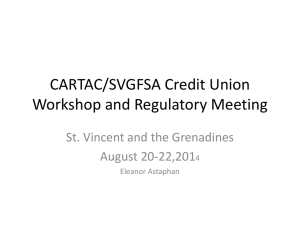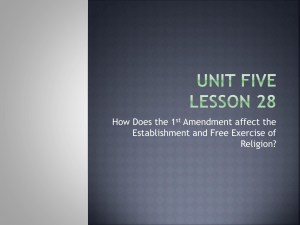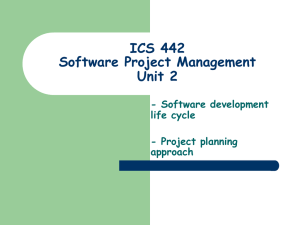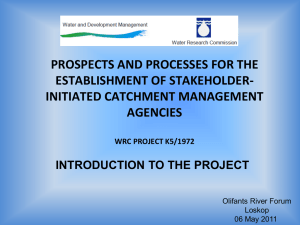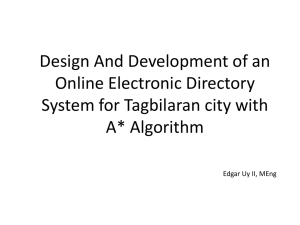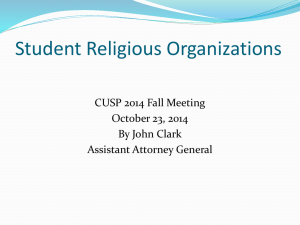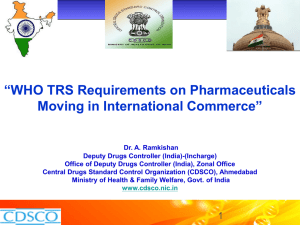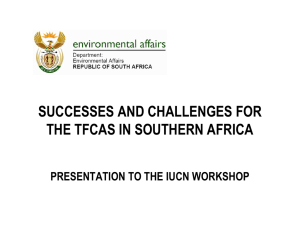The HRM and Performance Link: The Case of Adult Social
advertisement
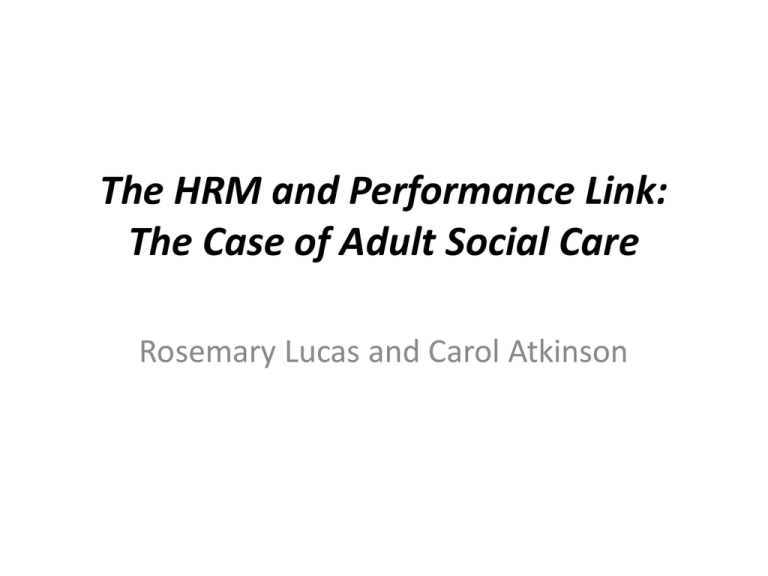
The HRM and Performance Link: The Case of Adult Social Care Rosemary Lucas and Carol Atkinson Introduction • DoH White Paper (2006) and Options for Excellence Review (2009) • Strategic approach to workforce planning & alignment of HR policies to organizational outcomes • Assumed positive relationship between HR practice & organizational performance • Project to address the links between rewards & incentives, recruitment & retention difficulties & outcomes for service users (quality & continuity of care) in adult social care Conceptual framework • Total reward systems (TRS) as the key HR intervention (tailored from limitations of HPWS & relevant to context) • Quality of care is key performance indicator (Eaton, 2000, De Prins and Henderickx, 2007) • TRS comprise a mix of monetary/non-monetary compensation + relational returns e.g. learning opportunities, recognition & status, challenging work, employment security (Milkovich and Newman, 1996) Conceptual framework • Right mix produces positive outcomes (Currall et al., 2005) but only where significant compensatory & relational returns both present (Siefert et al., 1990) • As TRS are costly can expect only to observe them in high quality employment sectors • How do employees perceive their TRS and what are the implications for quality and continuity of care? Social care • 1.75 million paid jobs; 40,000 establishments • Skills for Care lead role in training and quality framework • National Minimum Standards (NMS) e.g. staffing levels, skills and Care Quality Commission (CQC) inspection • Internal sector reports suggest positive progress in workforce strategy Other studies in social care • UK conventional wisdom of poor employment conditions and work experiences (Machin et al. 2003, Grimshaw & Carroll, 2002) • Good HR can have a positive impact for a minority in Australia (Harley et al., 2007) & N America (below) but may be mitigated by TU presence • Generally negative association (also Eaton, 2000) • Cannot be effective unless nature of work is changed (Berg & Frost, 2005) & workplace climate is supportive (Rondeau & Wagar, 2001) HR interventions and effects • No real consensus about features and efffects • Risk of different and unforeseen outcomes • TRS fits DoH strategic approach to adopt a set of behavioural HR interventions designed to recruit, retain, develop & motivate employees → organizational effectiveness • Employees best placed to judge effectiveness • Focus on front-line care workers (CW) Methods • Statistical analysis of National Minimum Dataset-Skills for Care (NMDS-SC) and possible connections to CQC ratings of quality • Scoring system to evaluate HR practices in establishment on 5 point scale (excellent to poor) • 18 establishments selected from sampling frame of 104 establishments Total compensation • Basic rates 30p above NMW (£5.73) in residential care and 45 p above in domiciliary care but seniority differentials as little as 20p more • Little additional compensation • …we look at profit and affordability; we recognise link between pay and recruitment and retention and try to pay more than other local providers. RM, Establishment, 15 Total compensation • Pay of little concern to CW & overridden by desire to help people, provide high quality care & make a difference • …you have to have a caring background to want to work in this environment as well to want to do this sort of job…it’s either there or not there...it’s not a job that you come to for the wages...or the glamour. CW, Establishment 5 Relational returns: social interaction • …even the cleaning staff…all muck in to help us…if we ever need anything doing by them they’re straightaway there. CW, Establishment 2 (teamwork) • ….they went to [location] and…hired a big, big coach and all the residents went out on day trip…I thought to myself…that is amazing. CW, Establishment 12 (sharing & friendship) • …we all talk together like on our phones…if a few of us are out on the road and we’ve got a bit of a gap time and we maybe meet at Tesco for a brekkie but otherwise we don’t really see each other. CW, Establishment 15 (to mitigate isolation and limited teamwork in domiciliary care) Relational returns: security • • • • • Fewer than 25% < 1 year’s service Half in same job for over 5 years 7 in 10 worked in care sector for over 5 years Three-quarters planned to stay No, as much as I'd love to [stay], I need to motivate and push myself further...get myself a highly qualified skill…. Going to uni and getting a degree…I was thinking about doing mental health nursing and I just went and sent my application off…would be good to push myself further. CW, Establishment 4 (commitment to sector) Relational returns: status, recognition & work importance • ...Over the years, especially my partner's friends…look up to people like me because not everybody can do that [carer’s job]…CW, Establishment 12 (status & pride) • …the only job I’ve ever done where I go home at the end of the day and I feel like I’ve really done something…it isn’t like the ‘same old, same old’ where you might work in a shop and you’re just sat on a till…you’re faced with new challenges every day and you know the smallest thing that you might do for somebody. CW, Establishment 15 (recognition & work importance) Relational returns: workload, work variety & work conditions • I used to go home very satisfied…Now…you're lucky if you have the time to do what you need to do without just having that little bit extra to be able to sit and you know have a minute talking to them….it's just not care. CW, Establishment 13 (staff shortages) • My nurses…and the other care staff understand that I have responsibilities outside. This is the first place I've ever worked…a lot of people say that this is one of the best places to work for people who have kids and other responsibilities. CW, Establishment 2 (flexibility & work-home balance) Relational returns: authority, control & autonomy • …that would probably depend what the decision was going to be…sometimes we haven't got the experience to make major decisions…they do try and involve you. CW, Establishment 2 (clear parameters) • …you’re not herded anywhere, you’re like left to just get on with it…they give you these clients and you’re responsible whilst you’re there for them…you’re the boss…I just…love the job. CW, Establishment 6 (autonomy) • …It’s difficult because you go from people with dementia to people with severe mental problems…it’s a bit scary…we have a lot of responsibility. CW, Establishment 16 (responsibility) Relational returns: feedback • Basically it’s a bit of an open session but we cover all areas. It’s very good. You come out and you think, oh glad you told me that. CW, Establishment 6 (formal supervision 2-3 months) • She’s on call 24 hours a day. If I’ve had a lot – you know, sometimes the work load gets a bit pressured, I get that support from her. CW, Establishment 10 (available help & support) Relational returns: development opportunities & advancement • [Manager]’s put on training days…going to do dementia care mapping, there’s about six of us in the group…In the process of changing all the corridors…having themed corridors…for improvement for their cognitive stimulation. CW, Establishment 13 (training to support innovation) • I’ve done the Dementia Course…then I did the Health and Safety…we get fire lectures every year…mandatory moving and handling, the health and safeties every three years I think – they’re increasing that…we’ve just finished Infection Control…so I’ve put my name down for the Medical Care one. CW, Establishment 14 (on and off-job training) Conclusions • Indications of HR interventions (TRS) having a positive effect & can work in low-value employment • Call into question that TRS must comprise significant compensatory & relational returns to produce positive outcomes • Supportive workplace climate, good management & health working relationships for most CW underpinned by supporting regulatory framework • Managerial change & work intensification clashed with some CW work orientations • Refutes wisdom that CW working lives are exploitative & unrewarding
